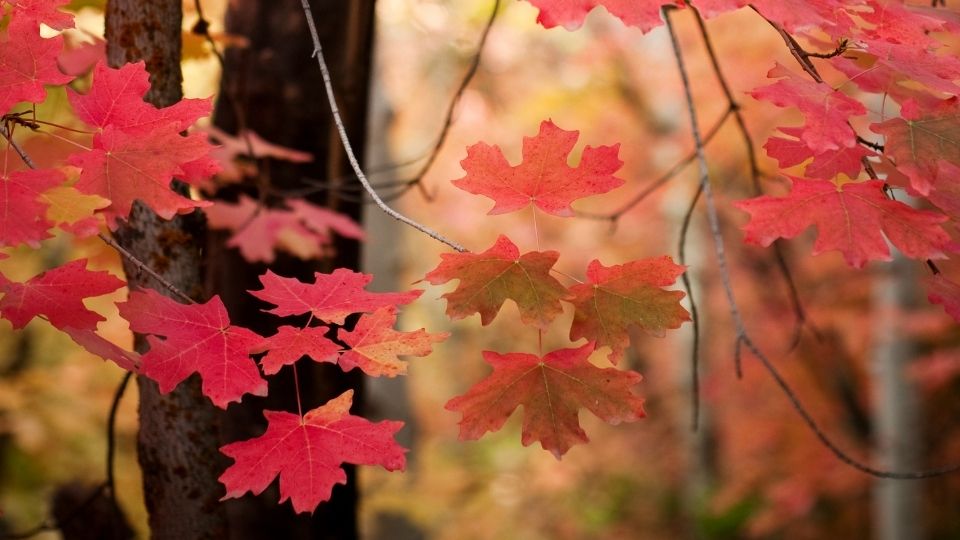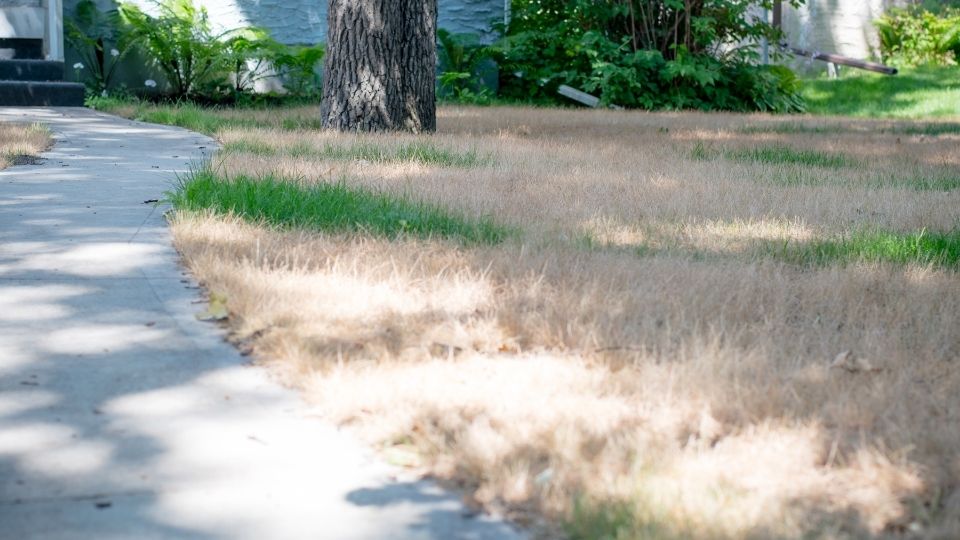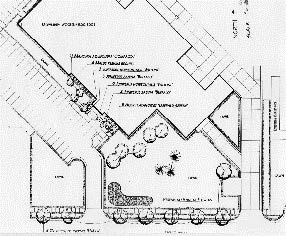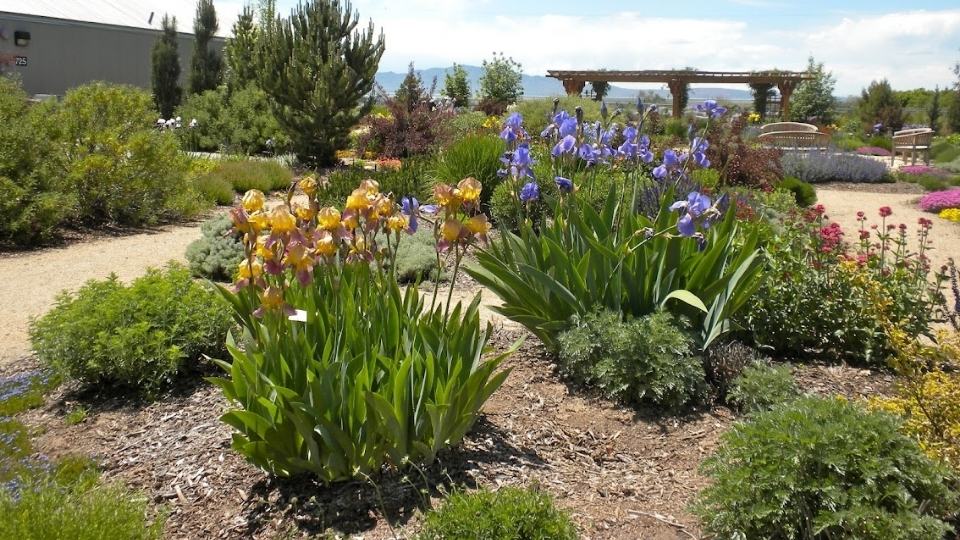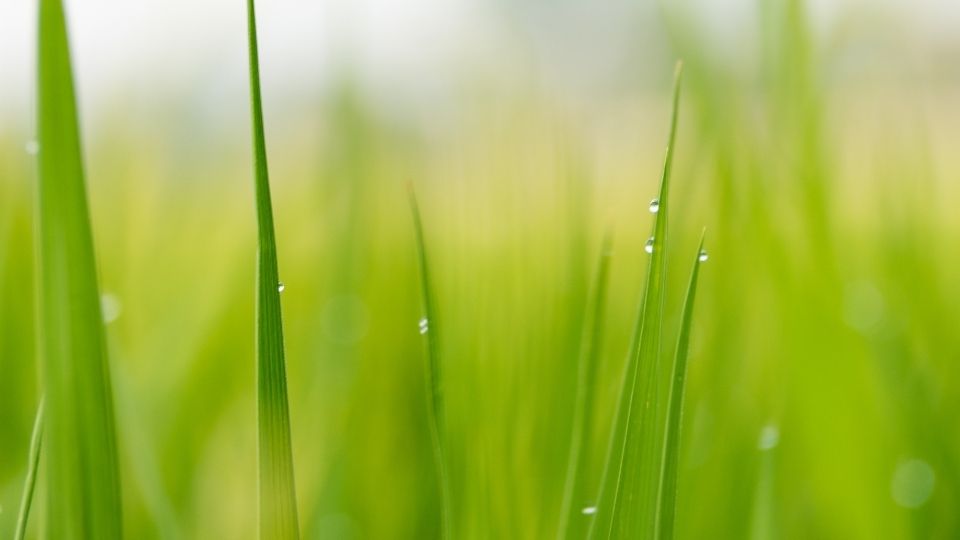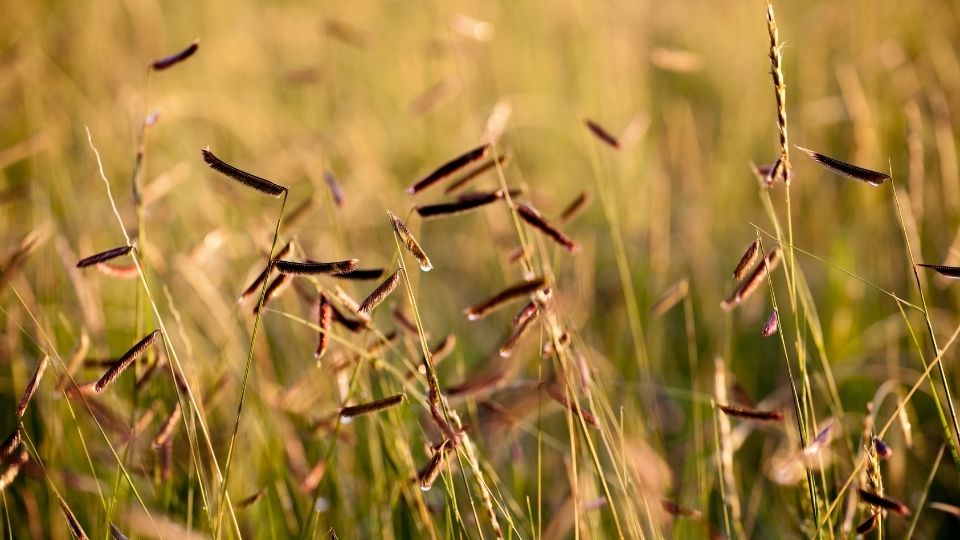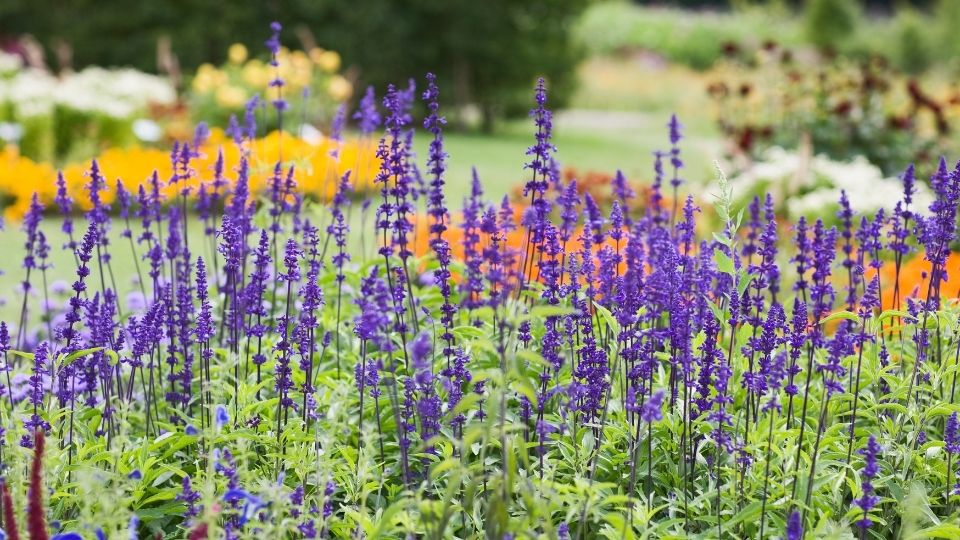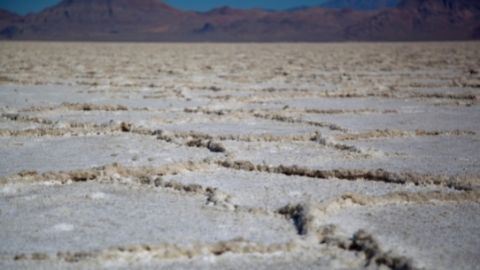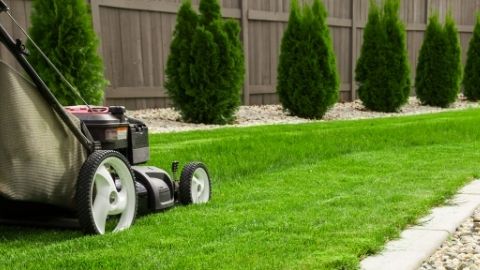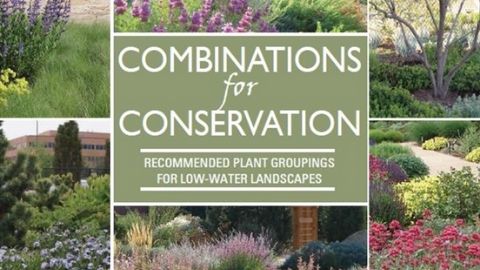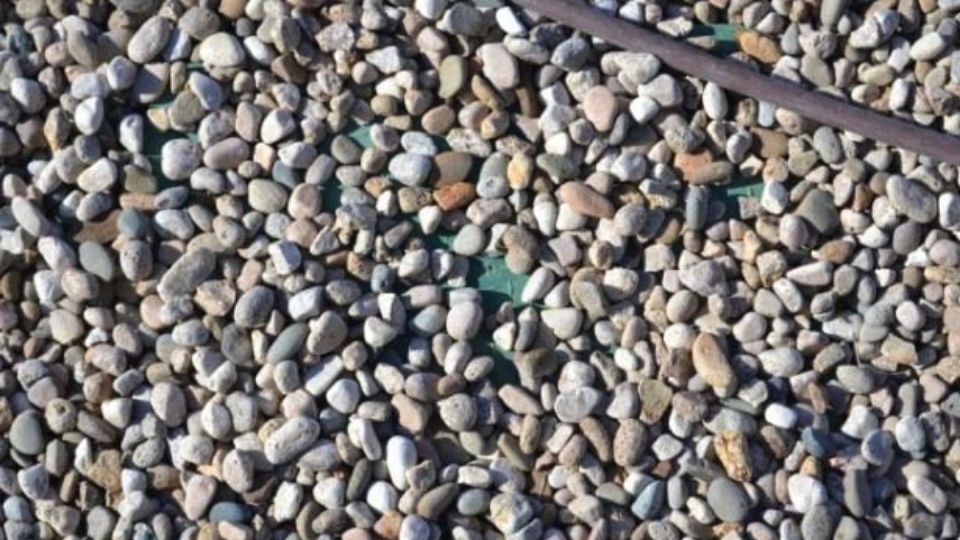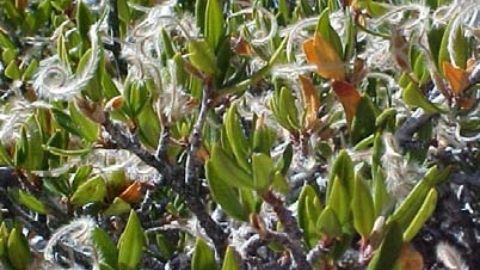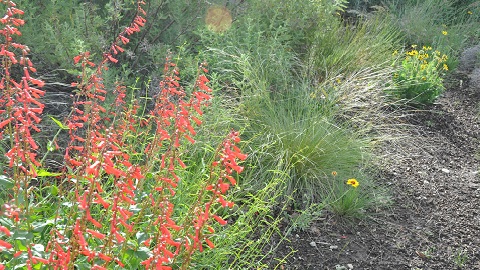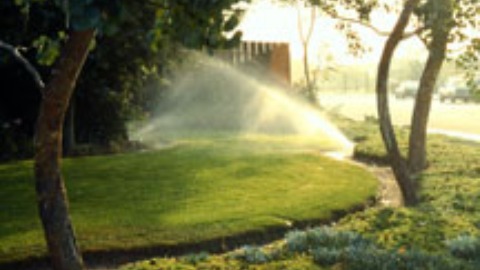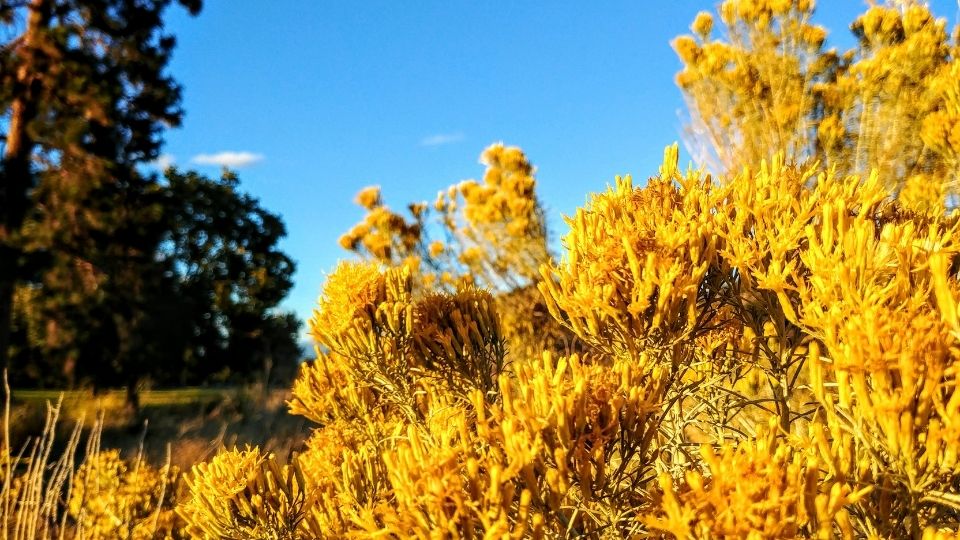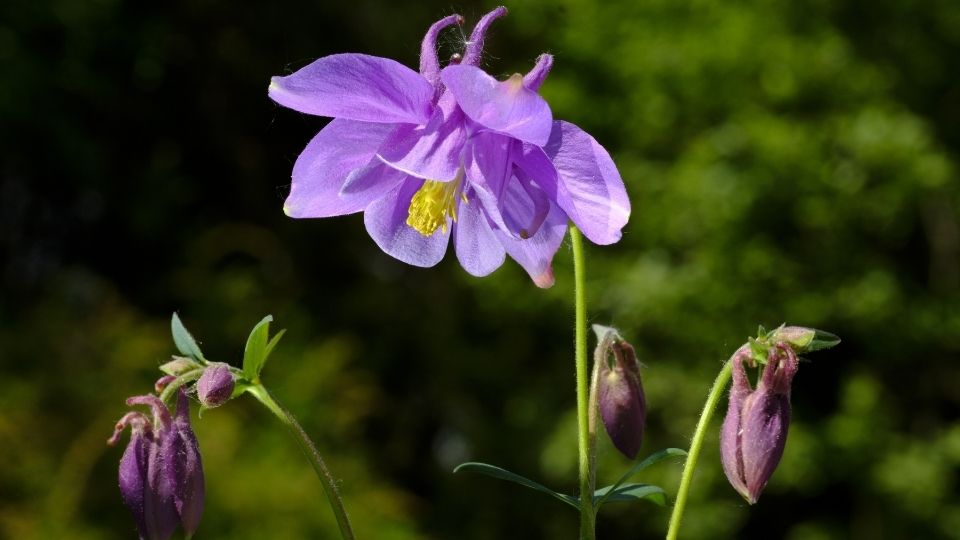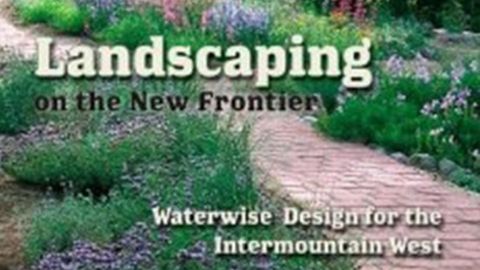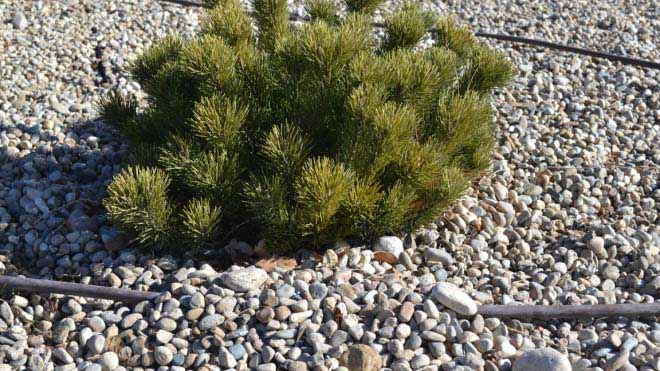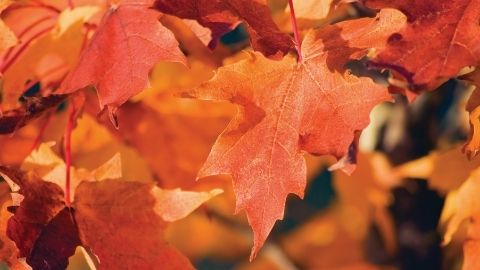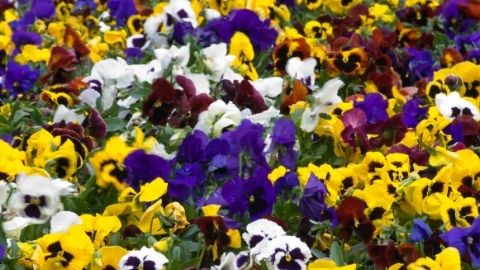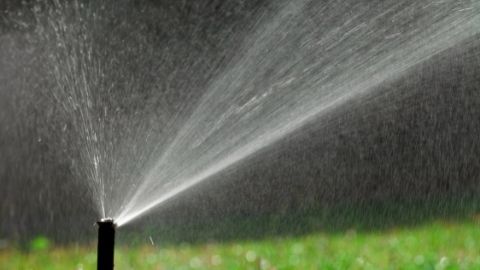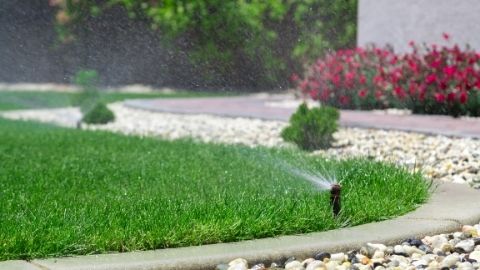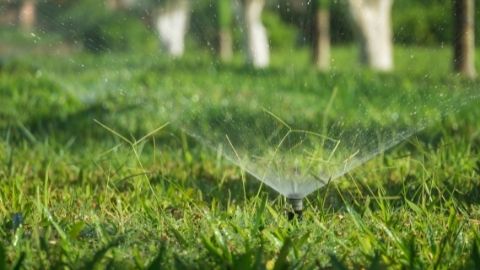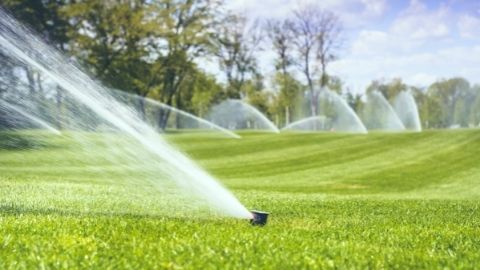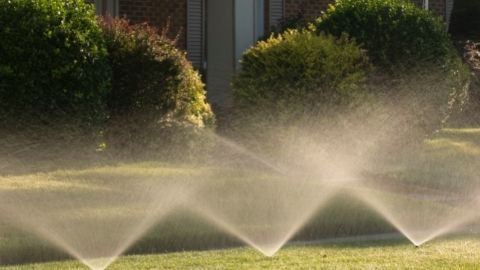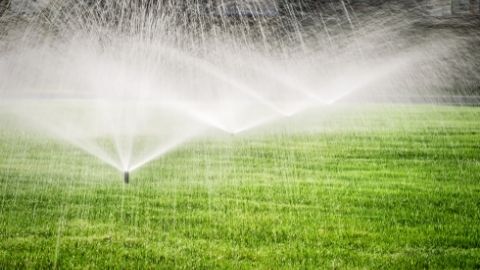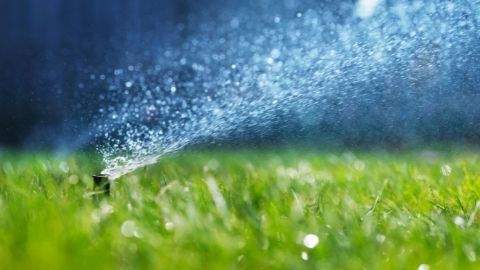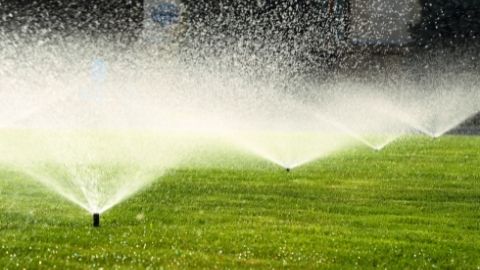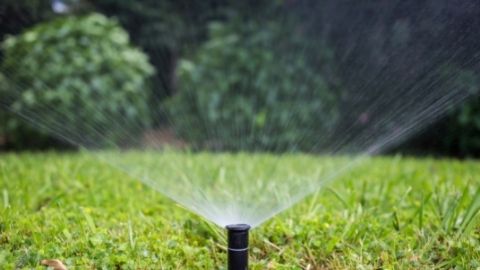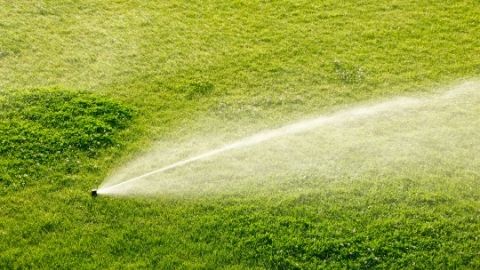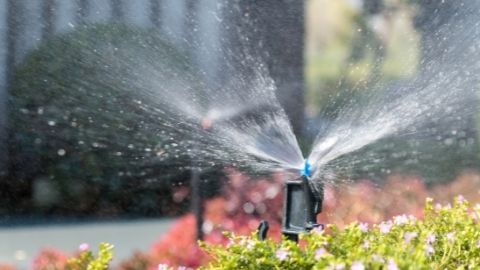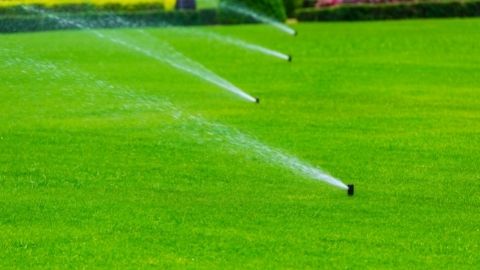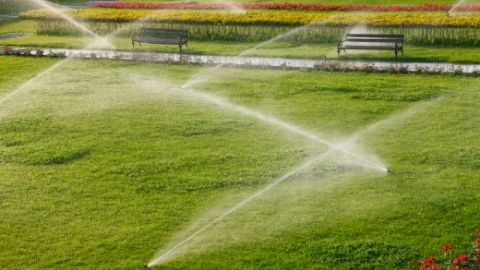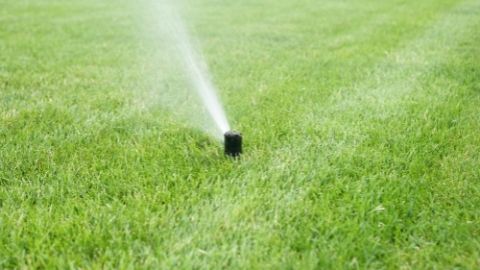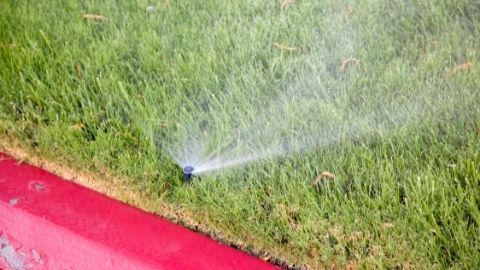Efficient Irrigation of Trees and Shrubs
June 2002
In Utah, urban landscape irrigation accounts for 50-75% of the annual municipal water use, and much of it is applied in excess of the plant’s needs. This excess is a tremendous resource waste and the overspray causes substantial damage to hardscape (i.e., decks, patios, fountains, decorative concrete, etc.). Scheduling irrigation according to landscape plant water needs can reduce excess water use. In addition to conserving water, proper irrigation can encourage deeper root growth and healthier, more drought tolerant landscapes.
Why Is Water Important to Plant?
Water is an essential component of plants. It aids in the movement of substances throughout the plant, serves as a medium for chemical reactions, and is necessary for photosynthesis. Most water use by plants, however, is due to transpiration. Transpiration is the loss of water through small openings in the leaf surface called stomates. Stomates also take in the gasses for photosynthesis. Transpiration creates a pull or suction that draws water up through the stem and roots from the soil. It also helps to cool the plant. Most water loss through transpiration is unavoidable, though some drought tolerant plants are good at minimizing the loss. Unless the roots have a continuous supply of water the plant will eventually wilt, though exposing a plant to moderate drought stress regularly can increase its ability to withstand drought. Eventually, if moisture is not added to reverse wilting, the plant will decline and die.
How Often Should You Water?
Trees and shrubs have much deeper and more extensive root systems than turfgrass so they should be watered less frequently but for longer periods of time. The optimum time to water is just before you observe any water stress. Therefore, it is important to determine sub-surface soil moisture. Soil moisture can be determined using a soil moisture probe (a screw driver or long metal rod would work too). The probe will easily penetrate moist soil but stops when it hits dry soil. The soil should be moist to a depth of 18-20 inches for trees and shrubs.
Soil moisture can also be determined by the “feel method.” Feel or squeeze a handful of soil to get an idea of the moisture level. Since the top layer of the soil will dry out faster than the rest of the soil profile, take the soil sample at a depth of about 4-8 inches, or below this depth if you are concerned with deep moisture. This is the area where many of the roots should be absorbing water as well. Sandy and loam soils are considered “dry,” with little or no available moisture for the plant, when the soil runs through your fingers and no stain remains on your hands. Clay soils are hard to break apart when they are dry. When moisture levels in the soil are optimum for the plant, you will be able to squeeze the soil to form a ball and a thin layer of moisture and stain will be left on your hands. No water should run out of the ball. If water runs out of the soil after squeezing it in your hands, it contains more than adequate amounts of moisture and should not be irrigated.
It is also important to estimate the amount of water lost from the landscape and predict how much water needs to be replaced. This is known as the “evapotranspiration method.” This method is specific for plant species, soil type and climatic conditions and, for trees and shrubs, is calculated based on the amount of water lost from the plant canopy. Evapotranspiration is the sum of the water lost from the soil surface through evaporation plus the water lost through transpiration from the plant. The evapotranspiration rate varies depending on such factors as temperature, humidity, wind, mulching, and soil type. See the related bulletin “Garden Water Use in Utah” (http://extension.usu.edu/publica/engr/bie/wm-37) for a table of seasonal water use estimates in your area.
How Much Should You Water?
Trees or shrubs should be watered to a depth of 18-20 inches. The amount of water to apply in any situation depends on the soil type. Sandy soils absorb water the fastest (about 2" per hour), followed by loam soils (3/4" per hour). Clay soils have the slowest absorption rate (1/2" per hour). By allowing water to penetrate deeper into the soil profile you are encouraging deeper rooting and a more drought tolerant plant. Frequent, light irrigations will lead to plants that have a shallow root system and that are more prone to water stress. When using sprinkler systems about 1/2 -1 inch of water may be required weekly for shrubs and smaller trees (<4" trunk diameter). For drip irrigation about 5-50 gallons of water may be required. These amounts would be higher in southern Utah and lower in northern Utah and would also depend on plant size. Large trees (>4" trunk diameter), depending on the size of the tree, may require hundreds of gallons of water per week. Water newly planted trees and shrubs more frequently until the root system is established. Also, mulch and control weeds and grasses around the trunk of the trees and shrubs to reduce competition for water and nutrients.
Symptoms of Water Stress
Wilting and leaf scorch are symptoms of water stress. However, over-watering of plants can create similar browning symptoms and even cause the leaves to drop. Roots need oxygen to survive and when the soil is over-saturated with water there is little oxygen for the plant’s roots. Without a healthy root system the plant is no longer able to absorb water and will show signs of water stress. Many gardeners assume these symptoms are from a lack of water and they will continue to add to the problem by over-watering, eventually causing the plant to die.
What is the Most Efficiently Way to Irrigate Landscape Plants?
Trees and Shrubs in Turf
Trees and shrubs located in turf areas benefit from normal lawn irrigation. However, during the warmer parts of the year (July and August) an extra, deep watering 1-3 times per month (either by the lawn irrigation or hand watering), depending on your location in the state, may be needed where you have trees and shrubs in turf areas.
Isolated Tree and Shrub Plantings
Drip irrigation, also known as trickle, micro-irrigation, or low volume irrigation, is an efficient way to water shrubs and smaller trees (< 4" trunk diameter), but is not appropriate for turfgrass or larger trees. In drip irrigation, water flows through flexible pipes or hoses and is applied directly to the root zone of the plants. Pressure is controlled by flow devices called emitters. Since little water is lost due to evaporation into the air or by run-off from the soil, the system uses much less water than traditional landscape sprinklers. The number of emitters used for each plant and the flow rate for each emitter will depend on the size of the plant. The goal is to adequately water the root zone of the plant without wasting water. Larger trees (>4" trunk diameter) should be irrigated using micro-sprinklers or bubblers which emit larger volumes of water and cover more of the root zone.
Irrigation Suggestions
To provide adequate water to all plants without over or under-watering some, group those with similar irrigation needs in one zone (an area of the yard or a specific zone of the irrigation system) and adjust irrigation systems in response to variations in the season. In the spring and fall, less water is lost from the plant and soil so less irrigation water is needed. Irrigate in cycles, instead of applying all the water at once, to avoid run-off. Turn off automatic systems during and after rains. Hand watering can also be an efficient way to water individual plants showing signs of water stress, assuming you apply the water slowly enough to be absorbed by the soil.
Sensitivity of Trees to Water Stress
Trees are rated below according to their relative drought tolerance - tolerance of low soil moisture, heat, and/or low humidity. Drought tolerance is a complicated trait, and the exact conditions a plant is exposed to are very important. European beech, for example, is rated low for drought tolerance, yet it can tolerate dry conditions if it has shade. Green ash, on the other hand, is rated high for drought tolerance, yet drought stress also can make it more susceptible to borer damage. In this case, white ash may be the better choice, even though it is only rated medium in drought tolerance. Some trees considered drought tolerant rely on deep root systems to avoid drought, but may become stressed if planted in shallow soils. Others such as pines and junipers, are able to maintain acceptable appearance even when they have run out of water in their root zone, regardless of how deep the soil is.
Finally, drought tolerance is only one of the criteria used to select which tree to plant. Trees in this list marked with * should only be planted with caution or when nothing else will survive. Trees marked + are not very cold tolerant and should only be planted in the warmest parts of Utah. For a more comprehensive listing of tree characteristics and selection criteria, see “Selecting and Planting Landscape Trees” (http://extension.usu.edupublica/natrpubs/nr460.pdf).
High Drought Tolerance
- Ash, Green (Fraxinus pennsylvanica)
- *Boxelder (Acer negundo)
- Catalpa, Northern or Western (Catalpa speciosa)
- *+Chinaberry (Melia azedarach)
- Coffeetree, Kentucky (Gymnocladus dioicus)
- Corktree, Amur (Phellodendron amurense)
- Elm, American (Ulmus americana)
- Elm, Lacebark or Chinese (Ulmus parvifolia)
- *Elm, Siberian or Chinese (Ulmus pumila)
- Ginkgo (Ginkgo biloba)
- Goldenraintree (Koelreuteria paniculata)
- Hackberry, Common (Celtis occidentalis)
- Hawthorns (Most) (Crataegus species)
- Honeylocust (Gleditsia triacanthos)
- Juniper, Chinese (Juniperus chinensis)
- Juniper, Rocky Mountain (Juniperus scopulorum)
- Juniper, Utah (Juniperus utahensis)
- Locust, Black (Robinia pseudoacacia)
- Maple, Amur or Ginnala (Acer ginnala)
- Maple, Sycamore (Acer pseudoplatanus)
- Maple, Tatarian (Acer tataricum)
- Maple, Trident (Acer buergeranum)
- Mulberries (Morus species)
- Oak, Bur (Quercus macrocarpa)
- Oak, Chinkapin (Quercus muehlenbergii)
- Oak, Gambel or Scrub (Quercus gambelii)
- Oak, Swamp White (Quercus bicolor)
- Osage-orange (Maclura pomifera)
- Pear, Callery (Pyrus calleryana)
- Pear, Common (Pyrus communis)
- Pine, Aleppo (Pinus halepensis)
- Pine, Austrian (Pinus nigra)
- Pine, Bristlecone (Pinus aristata)
- Pine, Japanese Black (Pinus thunbergiana)
- Pine, Limber (Pinus flexilis)
- Pine, Mugo (Pinus mugo)
- Pine, Ponderosa (Pinus ponderosa)
- Pine, Scotch or Scots (Pinus sylvestris)
- Pinyons (Pinus monophylla or Pinus edulis)
- Planetree, London (Platanus X acerifolia)
- Redbud, Eastern (Cercis canadensis)
- Redcedar, Eastern (Juniperus virginiana)
- *Russian-olive (Elaeagnus angustifolia)
- Smoketree, Common (Cotinus coggyria)
- *Tree-of-heaven or Ailanthus (Ailanthus
altissima) - Zelkova, Japanese (Zelkova serrata)
Medium Drought Tolerance
- Alders (Alnus species)
- Apple (Malus pumila)
- Apricot (Prunus armeniaca)
- Arborvitaes or White-cedars (Thuja species)
- Ash, White (Fraxinus americana)
- *Aspen, Quaking (Populus tremuloides)
- Baldcypress (Taxodium distichum)
- Catalpa, Umbrella (Catalpa bignonioides
'Nana') - Cedar of Lebanon (Cedrus libani)
- Cedar, Atlas (Cedrus atlantica)
- +Cedar, Deodar (Cedrus deodar)
- Cherry, European Bird, or May Day Tree
(Prunus padus) - Cherries, Ornamental (Prunus yedoensis and others)
- Cherry, Sour (Prunus cerasus)
- Cherry, Sweet (Prunus avium)
- Chokecherry, Common (Prunus virginiana)
- *Cottonwoods or Poplars (Populus species; some)
- Crabapples (Malus species)
- +Crapemyrtle (Lagerstroemia indica)
- Dogwood, Corneliancherry (Cornus mas)
- Falsecypress, Hinoki or Hinoki Cypress
(Chamaecyparis obtusa) - Filbert, Turkish (Corylus colurna)
- Fir, White (Abies concolor)
- Goldenchain Tree (Laburnum X watereri)
- Hawthorn, English (Crataegus laevigata)
- Hazelnuts (Corylus species)
- Holly, American (Ilex opaca)
- Hornbeam, European (Carpinus betulus)
- Horsechestnuts or Buckeyes (Aesculus species)
- Incense-cedar (Calocedrus decurrens)
- Lilac, Japanese Tree (Syringa reticulata)
- Lindens or Basswoods (Tilia species)
- +Magnolia, Southern (Magnolia grandiflora)
- Maple, Canyon or Bigtooth (Acer grandidentatum)
- Maple, Hedge (Acer campestre)
- Maple, Norway (Acer platanoides)
- Maple, Purpleblow or Shantung (Acer
truncatum) - Maple, Rocky Mountain (Acer glabrum)
- Maple, Sugar (Acer saccharum)
- Oak, English (Quercus robur)
- Oak, Northern Red (Quercus rubra)
- Oak, White (Quercus alba)
- Pagodatree, Japanese or Scholar-tree (Sophora japonica)
- Peach (Prunus persica)
- Pine, Himalayan or Bhutan (Pinus
wallichiana) - Pine, Japanese Red (Pinus densiflora)
- Pine, Japanese White (Pinus parviflora)
- Pine, Lacebark (Pinus bungeana)
- Plums (Prunus domestica and others)
- Redwood, Dawn (Metasequoia glyptostroboides)
- Serviceberry, Downy (Amelanchier arborea)
- Spruce, Blue or Colorado Blue (Picea
pungens) - Spruce, Norway (Picea abies)
Spruce, Serbian (Picea omorika) - Spruce, White or Blackhills (Picea glauca)
- Sweetgum or American Sweetgum
(Liquidambar styraciflua) - Walnuts (Juglans species)
- Yellow-poplar or Tuliptree or Tulip-poplar
(Liriodendron tulipifera) - Yellowwood (Cladrastis lutea or kentuckea)
Low Drought Tolerance
- Beech, European (Fagus sylvatica)
- *Birch, European White (Betula pendula)
- Birch, Water or River (Betula occidentalis)
- Dogwood, Kousa (Cornus kousa)
- Dogwood, Pagoda (Cornus alternifolia)
- Douglas-fir (Pseudotsuga menziesii)
- Katsuratree (Cercidiphyllum japonicum)
- Larches (Larix species)
- Magnolias (Magnolia species; most)
- Maple, Japanese (Acer palmatum)
- Maple, Paperbark (Acer griseum)
- Maple, Red (Acer rubrum)
- Mountain-ashes (Sorbus species; most)
- Sequoia, Giant (Sequoiadendron giganteum)
- *Willows (Salix species)
References
- Keane, T. Water-wise Landscaping. 1995. Utah State Univ. Cooperative Extension Service. http://extension.usu.edu/publica/gardpub2.htm
- Rupp, L. Living with Landscape Irrigation Restrictions. 1992. Utah State Univ. Cooperative Extension Service http://extension.usu.edu/publica/gardpub2.htm
Authors
Teresa A. Cerny, Ornamental Horticulture Specialist; Mike Kuhns, Forestry Specialist; Kelly L. Kopp, Water Conservation and Turfgrass Specialist; Michael Johnson, Grand County Extension Agent
Related Research




